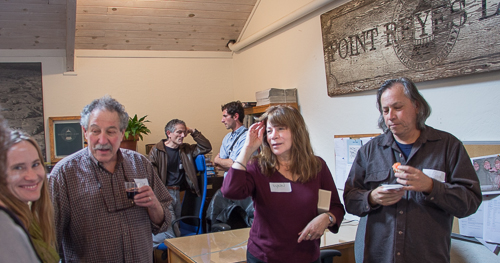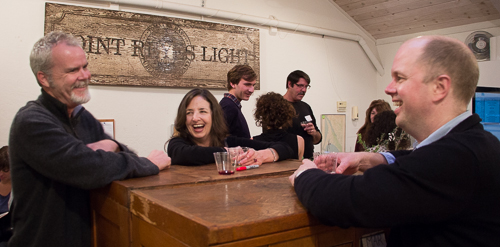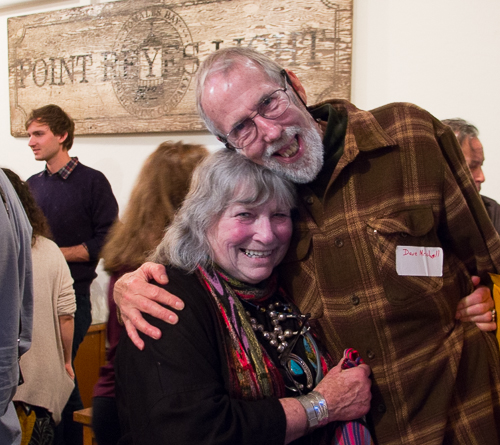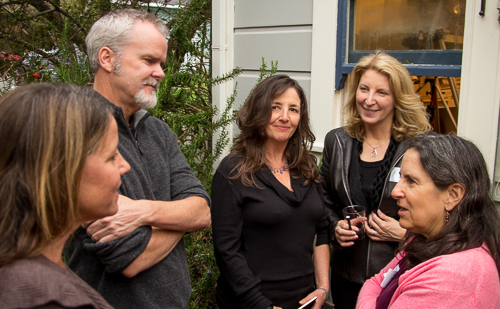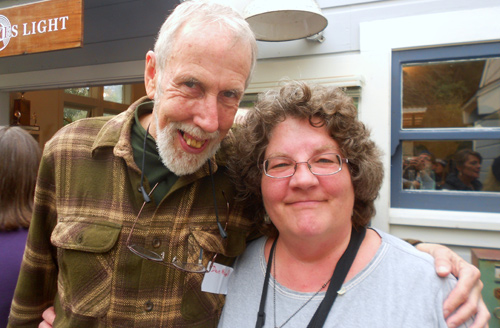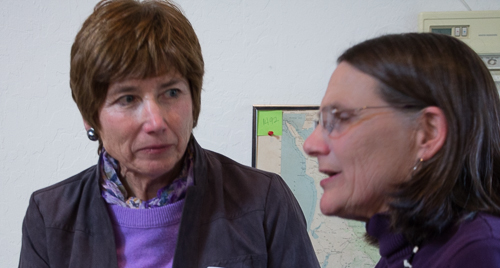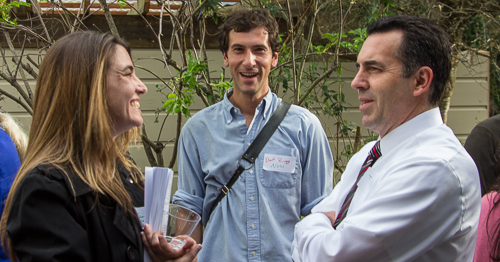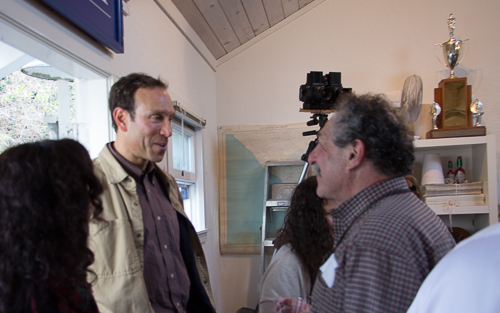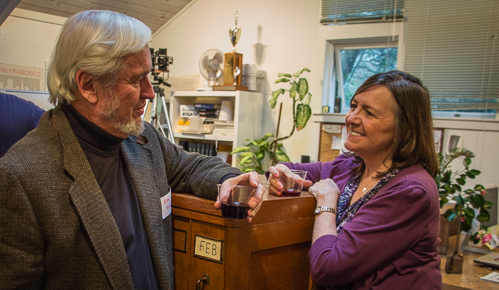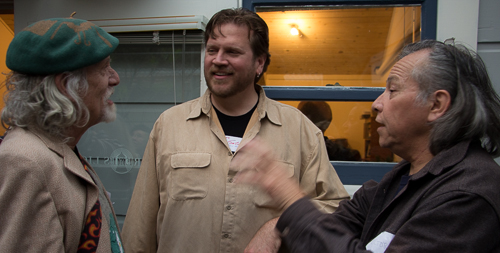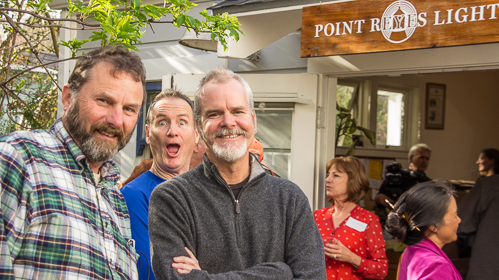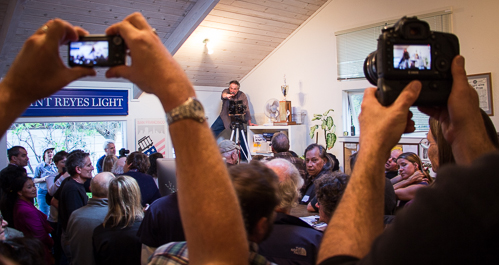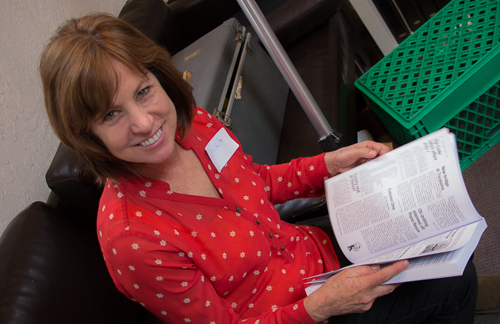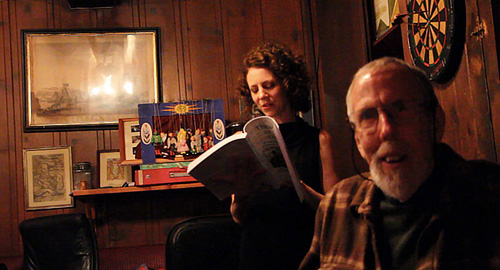Tue 4 Mar 2014
A gallery of photos from Point Reyes Light open house, staff reunion, and book readings
Posted by DavidMitchell under Dave Mitchell, General News, History, Inverness, Personal, Photography, The Point Reyes Light Newspaper
[2] Comments
During an open house and reunion Saturday, a happy throng of Point Reyes Light readers, staff, and columnists joined with former staff and correspondents to celebrate the 66th anniversary of the newspaper’s first issue. 
The reunion drew staff and contributors who had worked at the paper at different times during the past 44 years. A number of former staff traveled hundreds of miles to attend. A couple of them arrived from out of state.
From left: Laura Lee Miller, David Rolland (who drove up from San Diego), Cat Cowles, Wendi Kallins, Janine Warner (who drove up from Los Angeles), Elisabeth Ptak (back to camera), Gayanne Enquist, Art Rogers (talking with Elisabeth), Keith Ervin (who drove down from Seattle), B.G. Buttemiller, and (in blue shirt with back to camera) Victor Reyes. (Photo by Dave LaFontaine) ______________________________________________________________
 The party was also a celebration of the Tomales Regional History Center’s publishing The Light on the Coast: 65 Years of News Big and Small as Reported in The Point Reyes Light.
The party was also a celebration of the Tomales Regional History Center’s publishing The Light on the Coast: 65 Years of News Big and Small as Reported in The Point Reyes Light.
Stuart Chapman of Bolinas, a former member of the staff, shot this photo, which he titled “Dave, Proud Father” because I authored the book.
My co-author was Jacoba Charles. Jacoba reported for The Light under its previous ownership and is a member of the paper’s board of directors under its present ownership, Marin Media Institute.
The colored Post-its, by the way, mark selections that I, along with others, would be reading to attendees. ____________________________________________________________
From left: Co-author Jacoba Charles, photographer Art Rogers, scientist Corey Goodman, photographer David Briggs, editorial consultant on the book and former member of The Light’s ad department Lynn Axelrod, and Spanish-language columnist Victor Reyes. (Except where noted otherwise, the photos in this posting were shot by former Light reporter Janine Warner)
Michael Gahagan (left), who drove down from the Sierra Nevada town of Columbia to attend, published The Light from 1970 to 1975. Here he reminisces with historian Dewey Livingston of Inverness. Dewey for many years provided a weekly historical feature titled “West Marin’s Past.”
During the Gahagan years, Lee Sims (left) was the newspaper’s main typographer. This was back in the days before offset printing, and each page that went on the press had to be composed in lead.
In a piece written for The Light’s 30th anniversary in 1978 and reprinted in The Light on the Coast, Michael Gahagan’s former wife Annabelle comments, “Poor Lee, he had the disadvantage of being a friend of ours. One can always depend on friends, and we did lean on him! He was always underpaid and overworked. (Weren’t we all?)”
Catching up on old times are (in foreground from left): former news editor David Rolland, who drove to the reunion from San Diego, former typesetter Cat Cowles of Inverness, and former reporter Joel Reese, who flew in from Chicago. Standing behind them are current reporter Christopher Peak (left) and Matt Gallagher, who filled in as managing editor from February through July 2011. _____________________________________________________________
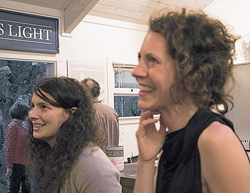 Samantha Kimmey (on the left) has been a reporter at The Light for the past year. With her is Tess Elliott of Inverness, who has been The Light’s editor for the past eight year. ____________________________________________________________
Samantha Kimmey (on the left) has been a reporter at The Light for the past year. With her is Tess Elliott of Inverness, who has been The Light’s editor for the past eight year. ____________________________________________________________
Gayanne Enquist was office manager during much of the 27 years I owned The Light. She was there when I arrived in July 1975, and she was there when I left in November 2005. (I was away reporting for the old San Francisco Examiner between September 1981 and the end of 1983.)
Former reporter Michelle Ling trades stories with Don Schinske, who was business manager during the 1990s and was co-publisher from 1995 to 1998. At left is her father, Dr. Walter Ling who teaches at UCLA. With his wife, May, Dr. Ling drove to Point Reyes Station for the celebration. In the background, Mary Papale listens intently to Laura Rogers.
Ingrid Noyes of Marshall (left) tells a story to my co-author, Jacoba Charles, outside The Light office.
Former staff recall the days of yore. From left: artist Laura Lee Miller, news editor David Rolland, typesetter Cat Cowles, reporter Janine Warner, and San Geronimo Valley correspondent Wendi Kallins. (Photo by Dave LaFontaine)
Sarah Rohrs was a reporter at The Light in the late 1980s. When several of us took turns reading aloud selections from The Light on the Coast, I read Sarah’s wonderfully droll account of a county fireman in Hicks Valley having to get a cow down out of a tree. (Photo by Joe Gramer)
Larken Bradley (left), who formerly wrote obituaries for The Light, chats with librarian Kerry Livingston, wife of Dewey.
Photographer Janine Dunn née Collins in 1995 traveled with news editor David Rolland to Switzerland’s Italian-speaking Canton of Ticino and to war-torn Croatia in doing research for The Light’s series on the five waves of historic immigration to West Marin. Here she chats with the paper’s current photographer David Briggs (center) and her husband John Dunn.
Former Light graphic artist Kathleen O’Neill (left) discusses newspapering in West Marin with present business manager Diana Cameron. _____________________________________________________________
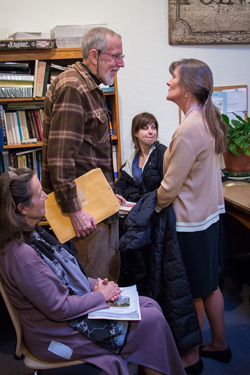 Former Light reporter Marian Schinske (right) and I wax nostalgic while photographic contributor Ilka Hartmann (left), looks on and Heather Mack (center), a graduate student in Journalism at UC Berkeley, takes notes. ____________________________________________________________
Former Light reporter Marian Schinske (right) and I wax nostalgic while photographic contributor Ilka Hartmann (left), looks on and Heather Mack (center), a graduate student in Journalism at UC Berkeley, takes notes. ____________________________________________________________
Former news editor Jim Kravets (left) jokes with photographer Art Rogers.
John Hulls of Point Reyes Station and Cynthia Clark of Novato have in the past worked with The Light in various capacities. In 1984, Cynthia set up the first computer system for the newsroom and ad department.
From left: Stuart Chapman of Bolinas, who formerly worked in The Light’s ad department, swaps stories with journalist Dave LaFontaine of Los Angeles and Light columnist Victor Reyes.
Historian Dewey Livingston (left), a former production manager at The Light, poses with former news editor David Rolland while former business manager Bert Crews of Tomales mugs in the background.
In preparing to shoot one of his signature group portraits, Art Rogers directs members of the crowd where to stand. With the throng crowded into the newspaper office, getting everyone in the right place to be seen was such a complicated operation that some of the photographer’s subjects began photographing him. _____________________________________________________________
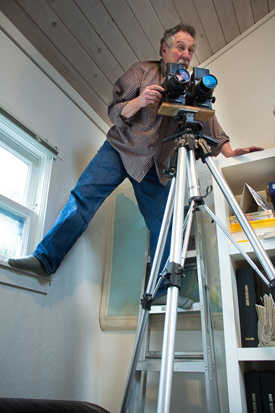 In shooting a series of three-dimensional photos, Art had to use a tall tripod and balance precariously on a window ledge and ladder. _____________________________________________________________
In shooting a series of three-dimensional photos, Art had to use a tall tripod and balance precariously on a window ledge and ladder. _____________________________________________________________
Art’s wife, Laura, who didn’t have to work nearly as hard, pages through a copy of The Light on the Coast. _______________________________________________________________
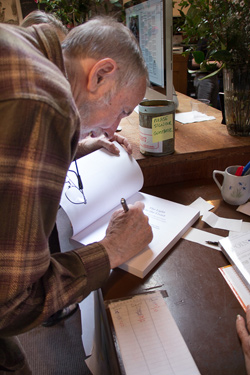 The party was in part a book-signing, and I signed copies off and on all afternoon. ______________________________________________________
The party was in part a book-signing, and I signed copies off and on all afternoon. ______________________________________________________
Light editor Tess Elliott reads Wilma Van Peer’s 1998 account of working for the paper’s founders, Dave and Wilma Rogers half a century earlier. The newspaper was called The Baywood Press when it began publishing in 1948. The paper’s fourth publisher, Don DeWolfe, changed the name to Point Reyes Light in 1966.
Originally the readings were scheduled to be held in the newspaper office, but so much socializing was going on they had to be delayed until the party moved around the corner to Vladimir’s Czech Restaurant where the banquet room had been reserved.
Among those reading besides Tess were Dewey Livingston, David Rolland, Matt Gallagher, and I. Anyone wishing to watch me read former publisher (1957 to 1970) Don DeWolfe’s account of his initiation to running the paper can click here.
It was a grand party, and I want to thank present Light staff, who made arrangements for the party, and former staff, some of whom traveled significant distances to attend the reunion.
Two other book readings are also scheduled. At 3 p.m. Sunday, March 9, in Point Reyes Presbyterian Church, Point Reyes Books will sponsor readings from The Light on the Coast and from Point Reyes Sheriff’s Calls, Susanna Solomon’s book of short stories inspired by Sheriff’s Calls in The Light.
At 4 p.m. Sunday, April 27, in its Corte Madera store, Book Passage will sponsor readings from The Light on the Coast. Refreshments will be served.

